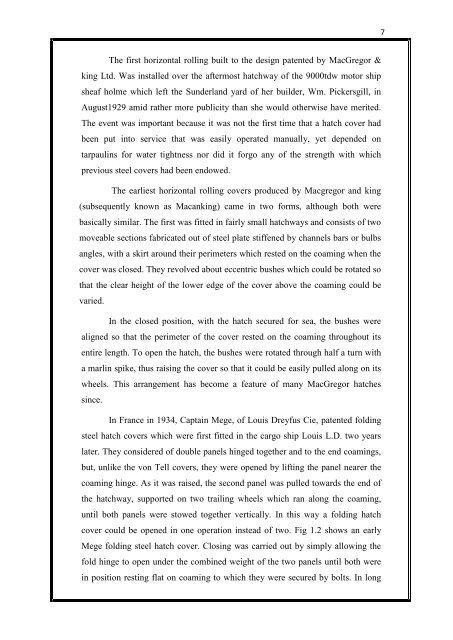Single pull macgregor type hatch cover.pdf - Cochin University of ...
Single pull macgregor type hatch cover.pdf - Cochin University of ...
Single pull macgregor type hatch cover.pdf - Cochin University of ...
You also want an ePaper? Increase the reach of your titles
YUMPU automatically turns print PDFs into web optimized ePapers that Google loves.
The first horizontal rolling built to the design patented by MacGregor &<br />
king Ltd. Was installed over the aftermost <strong>hatch</strong>way <strong>of</strong> the 9000tdw motor ship<br />
sheaf holme which left the Sunderland yard <strong>of</strong> her builder, Wm. Pickersgill, in<br />
August1929 amid rather more publicity than she would otherwise have merited.<br />
The event was important because it was not the first time that a <strong>hatch</strong> <strong>cover</strong> had<br />
been put into service that was easily operated manually, yet depended on<br />
tarpaulins for water tightness nor did it forgo any <strong>of</strong> the strength with which<br />
previous steel <strong>cover</strong>s had been endowed.<br />
The earliest horizontal rolling <strong>cover</strong>s produced by Macgregor and king<br />
(subsequently known as Macanking) came in two forms, although both were<br />
basically similar. The first was fitted in fairly small <strong>hatch</strong>ways and consists <strong>of</strong> two<br />
moveable sections fabricated out <strong>of</strong> steel plate stiffened by channels bars or bulbs<br />
angles, with a skirt around their perimeters which rested on the coaming when the<br />
<strong>cover</strong> was closed. They revolved about eccentric bushes which could be rotated so<br />
that the clear height <strong>of</strong> the lower edge <strong>of</strong> the <strong>cover</strong> above the coaming could be<br />
varied.<br />
In the closed position, with the <strong>hatch</strong> secured for sea, the bushes were<br />
aligned so that the perimeter <strong>of</strong> the <strong>cover</strong> rested on the coaming throughout its<br />
entire length. To open the <strong>hatch</strong>, the bushes were rotated through half a turn with<br />
a marlin spike, thus raising the <strong>cover</strong> so that it could be easily <strong>pull</strong>ed along on its<br />
wheels. This arrangement has become a feature <strong>of</strong> many MacGregor <strong>hatch</strong>es<br />
since.<br />
In France in 1934, Captain Mege, <strong>of</strong> Louis Dreyfus Cie, patented folding<br />
steel <strong>hatch</strong> <strong>cover</strong>s which were first fitted in the cargo ship Louis L.D. two years<br />
later. They considered <strong>of</strong> double panels hinged together and to the end coamings,<br />
but, unlike the von Tell <strong>cover</strong>s, they were opened by lifting the panel nearer the<br />
coaming hinge. As it was raised, the second panel was <strong>pull</strong>ed towards the end <strong>of</strong><br />
the <strong>hatch</strong>way, supported on two trailing wheels which ran along the coaming,<br />
until both panels were stowed together vertically. In this way a folding <strong>hatch</strong><br />
<strong>cover</strong> could be opened in one operation instead <strong>of</strong> two. Fig 1.2 shows an early<br />
Mege folding steel <strong>hatch</strong> <strong>cover</strong>. Closing was carried out by simply allowing the<br />
fold hinge to open under the combined weight <strong>of</strong> the two panels until both were<br />
in position resting flat on coaming to which they were secured by bolts. In long<br />
7

















